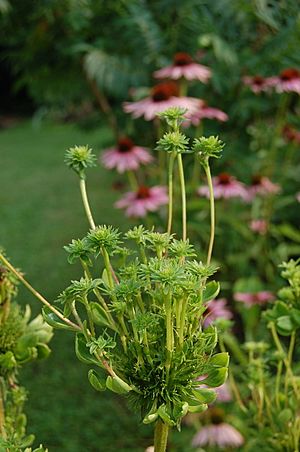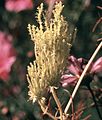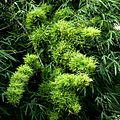Phytoplasma facts for kids
Quick facts for kids Phytoplasma |
|
|---|---|
 |
|
| Phyllody caused by phytoplasma infection on a coneflower (Echinacea purpurea) | |
| Scientific classification |
|
| Domain: | Bacteria |
| Phylum: | Tenericutes |
| Class: | Mollicutes |
| Order: | Acholeplasmatales |
| Family: | Acholeplasmataceae |
| Genus: | Candidatus Phytoplasma |
| Species | |
|
|
Phytoplasmas are tiny, special types of bacteria that act like parasites. This means they live inside other living things and get their food from them. They are known for causing serious diseases in many important plants, like coconut trees, sugarcane, and sandalwood.
Scientists first discovered phytoplasmas in 1967. Back then, they were called "mycoplasma-like organisms" or MLOs. These bacteria are very tricky because they cannot be grown in vitro (which means in a laboratory dish). This makes it hard for scientists to study them and learn more about how they work. Because they are so difficult to grow, they are given a special scientific name, "Candidatus".
Contents
What are Phytoplasmas?
Phytoplasmas are very small bacteria that do not have a cell wall, which is unusual for bacteria. They are obligate parasites, meaning they can only survive and multiply inside living cells. Specifically, they live in the phloem tissue of plants. The phloem is like the plant's food delivery system, moving sugars and nutrients from the leaves to other parts of the plant.
How Phytoplasmas Spread
Phytoplasmas cannot move from plant to plant on their own. They rely on insects to carry them. These insects are called vectors. Common vectors include leafhoppers and planthoppers. When an infected insect feeds on a healthy plant, it injects the phytoplasmas into the plant's phloem tissue. Once inside, the phytoplasmas multiply and spread throughout the plant.
What They Do to Plants
Phytoplasmas cause many different diseases in plants, leading to strange and harmful symptoms. These diseases can seriously damage crops, affecting farmers and food supplies.
Some common symptoms of phytoplasma diseases include:
- Yellowing of leaves: Leaves might turn yellow or reddish, even when they should be green.
- Stunted growth: Plants may stop growing properly and remain much smaller than healthy plants.
- Witches' broom: This is when a plant grows many small, weak shoots in a dense cluster, looking like a broom.
- Phyllody: Flowers can change into leaf-like structures, and the plant might not produce normal fruits or seeds.
- Virescence: Flower parts that are usually colorful might stay green.
- Dieback: Branches or entire parts of the plant may start to die from the tips downwards.
These symptoms show that the phytoplasmas are interfering with the plant's normal growth and development by disrupting its phloem system.
Images for kids
-
A grape vine with "bois noir" phytoplasma disease
-
Symptoms of aster yellows on marigold
-
Symptoms of elm phloem necrosis phytoplasma
-
Brinjal Little leaf phytoplasma
-
Trees dying of ash yellows phytoplasma
-
Symptoms of sweet potato little leaf phytoplasma on Catharanthus roseus
-
Phyllody of goldenrod
-
Soybean Phytoplasma
-
Witches' broom on bamboo (Dendrocalamus strictus)
-
Trillium grandiflorum with virescent petals
See also
 In Spanish: Phytoplasma para niños
In Spanish: Phytoplasma para niños



















